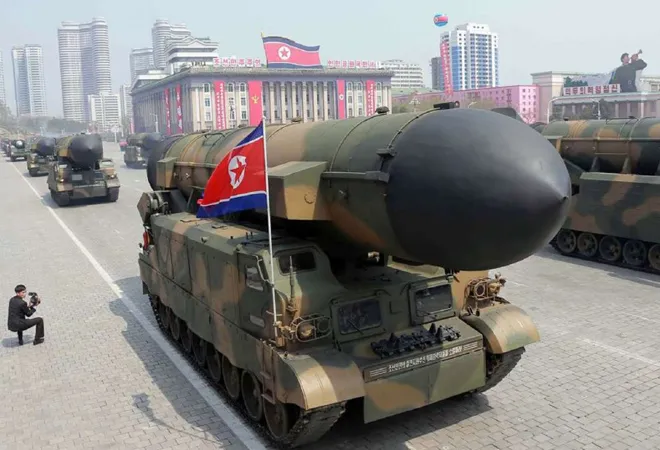After a week of sparring over North Korea’s missile and nuclear programmes that had many fearing the two countries were stumbling toward military conflict, the rhetoric has been scaled back by both the Trump administration and the North Korean regime of Kim Jong Un. Kim has said he would hold off and see “if the Yankees persist in their extremely dangerous reckless actions on the Korean peninsula and in its vicinity,” before making any decision.
So Pyongyang, it seems, is now willing to wait a bit before firing off ballistic missiles in the direction of Guam, as threatened before. Trump, on his part, praised the North Korean leader for appearing to back down on his threat in a tweet: “Kim Jong Un of North Korea made a very wise and well-reasoned decision. The alternative would have been both catastrophic and unacceptable!”
This came after incendiary tweets and comments from President Donald Trump threatening war with North Korea and Venezuela. After US intelligence agencies estimated that North Korea had miniaturised a nuclear warhead that could be fitted onto ICBMs tested last month, Trump suggested that any North Korean threat “will be met with fire and fury like the world has never seen.” North Korea, in turn, threatened that it planned to strike near Guam as soon as mid-August, raising the stakes in this game of chicken.
But even as Trump was doing what he clearly relishes, raising the decibel level, other members of his administration were busy diplomatically managing the crisis. There have been growing concerns that Trump’s over-the-top rhetoric would end up limiting the space for diplomatic manoeuvring for the US to manage a complex problem. Regional allies of the US have also been calibrating their responses. American and Japanese officials engaged each other in Washington last week for a meeting of the Security Consultative Committee, the first time the group has met since April 2015. Managing North Korea was clearly at the top of the agenda.
Also, two US Air Force B-1B bombers from Andersen Air Force Base on Guam and two Japanese F-15 jet fighters conducted drills southwest of the Korean peninsula last week. In the coming days, American and South Korean forces will be conducting an annual war game guaranteed to anger the North, which sees such demonstrations as a provocation. But in a sign of declining American credibility, South Korean President Moon Jae-in has also suggested that his country can no longer rely on Washington for protection even as he maintained that North Korea would be “crossing a red line” if it put a nuclear warhead on an intercontinental ballistic missile.
China’s role, as always, has been critical in this crisis given the close ties it shares with North Korea. Ninety per cent of North Korea’s trade is with China, and as the crisis escalated, Beijing decided to ban import of iron, lead, and coal from North Korea in line with new UN sanctions. For China, the bluster of Trump and Kim makes for a potent mix. Even as it has been tightening the noose around Pyongyang, it is also engaging with the US. It made sure that Gen. Joseph Dunford, who was in China, made a rare visit to the Chinese armed forces command that oversees the territory bordering North Korea. Chinese state media has also made it clear Beijing should not come to North Korea’s aid if the hermit kingdom launches missiles against the United States, but that China would have North Korea’s back if it was the victim of US or South Korean aggression. China’s actual policies are trying to prop up the North Korean regime by supplying oil on a sustained basis. Not surprising, therefore, that US and Japan are trying to put greater pressure on China to use its leverage, vis-à-vis the North Korean regime and the Trump Administration is gearing up to impose unilateral economic sanctions on Chinese firms doing business with Pyongyang.
This commentary originally appeared in DNA.
The views expressed above belong to the author(s). ORF research and analyses now available on Telegram! Click here to access our curated content — blogs, longforms and interviews.




 PREV
PREV


